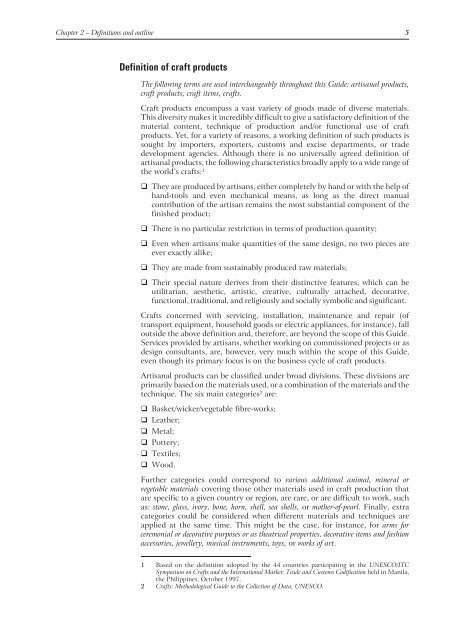Marketing Crafts and Visual Arts: The Role of Intellectual ... - WIPO
Marketing Crafts and Visual Arts: The Role of Intellectual ... - WIPO
Marketing Crafts and Visual Arts: The Role of Intellectual ... - WIPO
You also want an ePaper? Increase the reach of your titles
YUMPU automatically turns print PDFs into web optimized ePapers that Google loves.
Chapter 2 – Definitions <strong>and</strong> outline 5<br />
Definition <strong>of</strong> craft products<br />
<strong>The</strong> following terms are used interchangeably throughout this Guide: artisanal products,<br />
craft products, craft items, crafts.<br />
Craft products encompass a vast variety <strong>of</strong> goods made <strong>of</strong> diverse materials.<br />
This diversity makes it incredibly difficult to give a satisfactory definition <strong>of</strong> the<br />
material content, technique <strong>of</strong> production <strong>and</strong>/or functional use <strong>of</strong> craft<br />
products. Yet, for a variety <strong>of</strong> reasons, a working definition <strong>of</strong> such products is<br />
sought by importers, exporters, customs <strong>and</strong> excise departments, or trade<br />
development agencies. Although there is no universally agreed definition <strong>of</strong><br />
artisanal products, the following characteristics broadly apply to a wide range <strong>of</strong><br />
the world’s crafts: 1<br />
� <strong>The</strong>y are produced by artisans, either completely by h<strong>and</strong> or with the help <strong>of</strong><br />
h<strong>and</strong>-tools <strong>and</strong> even mechanical means, as long as the direct manual<br />
contribution <strong>of</strong> the artisan remains the most substantial component <strong>of</strong> the<br />
finished product;<br />
� <strong>The</strong>re is no particular restriction in terms <strong>of</strong> production quantity;<br />
� Even when artisans make quantities <strong>of</strong> the same design, no two pieces are<br />
ever exactly alike;<br />
� <strong>The</strong>y are made from sustainably produced raw materials;<br />
� <strong>The</strong>ir special nature derives from their distinctive features, which can be<br />
utilitarian, aesthetic, artistic, creative, culturally attached, decorative,<br />
functional, traditional, <strong>and</strong> religiously <strong>and</strong> socially symbolic <strong>and</strong> significant.<br />
<strong>Crafts</strong> concerned with servicing, installation, maintenance <strong>and</strong> repair (<strong>of</strong><br />
transport equipment, household goods or electric appliances, for instance), fall<br />
outside the above definition <strong>and</strong>, therefore, are beyond the scope <strong>of</strong> this Guide.<br />
Services provided by artisans, whether working on commissioned projects or as<br />
design consultants, are, however, very much within the scope <strong>of</strong> this Guide,<br />
even though its primary focus is on the business cycle <strong>of</strong> craft products.<br />
Artisanal products can be classified under broad divisions. <strong>The</strong>se divisions are<br />
primarily based on the materials used, or a combination <strong>of</strong> the materials <strong>and</strong> the<br />
technique. <strong>The</strong> six main categories 2 are:<br />
� Basket/wicker/vegetable fibre-works;<br />
� Leather;<br />
� Metal;<br />
� Pottery;<br />
� Textiles;<br />
� Wood.<br />
Further categories could correspond to various additional animal, mineral or<br />
vegetable materials covering those other materials used in craft production that<br />
are specific to a given country or region, are rare, or are difficult to work, such<br />
as: stone, glass, ivory, bone, horn, shell, sea shells, or mother-<strong>of</strong>-pearl. Finally, extra<br />
categories could be considered when different materials <strong>and</strong> techniques are<br />
applied at the same time. This might be the case, for instance, for arms for<br />
ceremonial or decorative purposes or as theatrical properties, decorative items <strong>and</strong> fashion<br />
accessories, jewellery, musical instruments, toys, or works <strong>of</strong> art.<br />
1 Based on the definition adopted by the 44 countries participating in the UNESCO/ITC<br />
Symposium on <strong>Crafts</strong> <strong>and</strong> the International Market: Trade <strong>and</strong> Customs Codification held in Manila,<br />
the Philippines, October 1997.<br />
2 <strong>Crafts</strong>: Methodological Guide to the Collection <strong>of</strong> Data, UNESCO.

















